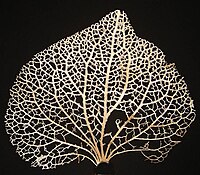
Photo from wikipedia
A 45-year-old man was referred to our endoscopy unit because of a benign refractory hepaticojejunal anastomotic stricture. Previous transhepatic anastomotic dilations had failed to guarantee longterm patency. We proposed endoscopic… Click to show full abstract
A 45-year-old man was referred to our endoscopy unit because of a benign refractory hepaticojejunal anastomotic stricture. Previous transhepatic anastomotic dilations had failed to guarantee longterm patency. We proposed endoscopic ultrasound (EUS)-guided duodenojejunostomy created using a lumen-apposing metal stent (LAMS) to allow endoscopic management of the bilioenteric stricture. The efferent limb was filled with water and contrast medium from the percutaneous biliary transhepatic drainage (PTBD) (▶Fig. 1 a, b). Then under EUS guidance, a LAMS (Hot-Axios, 10× 15mm) was deployed from the duodenal bulb into the target jejunal loop, using pure cut effect 4. A long 0.025-inch guidewire was coiled inside the loop. Under fluoroscopic and endoscopic guidance both flanges of the LAMS were successfully deployed without complications (▶Video1). In the same session, a fully covered selfexpandable metal stent (FCSEMS) (Wallflex; Boston Scientific) was deployed across the stenosed bilioenteric anastomosis (▶Fig. 2). The patient started on an oral diet the same day and he was discharged on day 1. At 6-month follow-up, upper endoscopy was performed with easy passage through the LAMS to remove the FCSEMS. Subsequent evaluation highlighted a good patency of the anastomosis with no secondary biliary stones (▶Video1). At 9 months after the EUS-guided duodenojejunostomy and 3 months from FCSEMS removal the patient is asymptomatic with normal liver test results. The LAMS is still in place. Benign stricture may occur in up to 24% of cases after bilioenteric anastomosis [1], and PTBD is the gold standard treatment. EUS-guided anastomosis using a LAMS is becoming standardized in tertiary centers, for cholecystogastrostomy, gastrojejunal anastomosis, and in cases of altered anatomy [2, 3]. We report one of the first cases of EUSguided duodenojejunostomy where a prior PTBD was used to fill the target jejunal loop with water and contrast medium. Direct EUS-guided transgastric hepatic injection in order to fill the jejunal loop is another viable option that would allow a single-operator single-session procedure. E-Videos
Journal Title: Endoscopy
Year Published: 2019
Link to full text (if available)
Share on Social Media: Sign Up to like & get
recommendations!